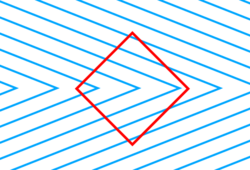Physics:Orbison illusion: Difference between revisions
From HandWiki
imported>LinXED (url) |
(No difference)
|
Latest revision as of 17:30, 10 June 2021
The Orbison illusion (or Orbison's illusion) is an optical illusion first described by American psychologist William Orbison (1912–1952)[1] in 1939.
The illusion consists of a two dimensional figure, such as a circle or square, superimposed over a background of radial lines or concentric circles. The result is an optical illusion in which both the figure and the rectangle which contains it appear distorted; in particular, squares appear slightly bulged, circles appear elliptical, and the containing rectangle appears tilted.[2]
References
- ↑ Roeckelein, Jon E. (2006). Elsevier's Dictionary of Psychological Theories. Amsterdam: Elsevier. p. 651. ISBN 9780444517500. https://books.google.com/books?id=1Yn6NZgxvssC&q=william+orbison+psychologist&pg=PA651.
- ↑ "Orbison illusion". http://www.optical-illusions.info/illusions/Orbison_illusion.htm.
- Fineman, Mark (1996). The Nature of Visual Illusion. Dover Publications. pp. 152-153. ISBN 0486291057. https://archive.org/details/natureofvisualil0000fine/page/152.
- Robinson, J.O. (1998). The Psychology of Visual Illusion. Dover Publications. pp. 72–73. ISBN 978-0486404493.
| Wikimedia Commons has media related to Optical illusion. |
 |


